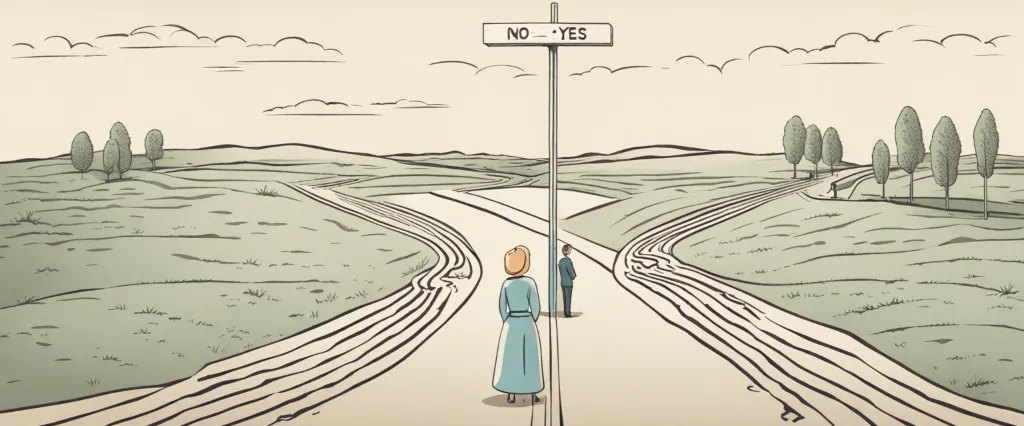——Go for No Yes is the Destination No is How You Get There by Richard Fenton & Immunity To Change by Robert Kegan

In the realm of personal development and self-improvement, numerous books offer insightful perspectives and practical techniques to help individuals navigate the journey towards growth. Two such books, “Go for No: Yes is the Destination, No is How You Get There” by Richard Fenton and “Immunity to Change” by Robert Kegan, delve into distinct approaches to personal transformation. While both books hold invaluable knowledge, their divergent methodologies and perspectives invite us to explore the dynamic interplay between embracing failure and identifying hidden obstacles. By analyzing the contrasting yet complementary ideas within these works, this comparative study aims to unravel the intricate threads that underlie the pursuit of success, personal change, and resilience amidst challenges. Through an exploration of the authors’ unique frameworks, we will uncover the ways in which these texts shed light on different facets of personal growth, ultimately offering readers a richer understanding of the complex nature of human progress.
Brief Summary of Two Books
Go for No Yes is the Destination No is How You Get There by Richard Fenton
“Go for No! Yes is the Destination, No is How You Get There” by Richard Fenton and Andrea Waltz is a motivational and self-help book that challenges conventional thinking about success and rejection. The authors emphasize the importance of embracing rejection and seeing it as a stepping stone towards achieving goals.
Using relatable stories, the book follows the journey of Eric, a reluctant salesperson who fears rejection. Through a fateful encounter with a mysterious character named Ray, Eric learns the power of reframing failure and redefines what it means to be successful. Ray introduces him to the philosophy of “going for no,” which means actively seeking out rejection and pursuing a high volume of sales calls, knowing that each “no” brings him closer to a “yes.”
The book’s central message is that true success lies in redefining our relationship with failure. It encourages readers to overcome the fear of rejection by shifting their mindset from avoiding “no” to actively seeking it. By doing so, individuals can build resilience and expand their comfort zones, ultimately increasing the likelihood of achieving their desired outcomes.
“Go for No!” provides practical strategies and tips to implement the “go for no” philosophy. It challenges readers to set ambitious goals, embrace rejection as a learning experience, and persistently pursue opportunities, even in the face of setbacks.
Overall, “Go for No! Yes is the Destination, No is How You Get There” invites readers to rethink their approach to rejection. It advocates a mindset shift towards actively pursuing rejection and using failures as stepping stones towards success. Through engaging stories and practical advice, the book inspires individuals to overcome fear and redefine their relationship with rejection in order to achieve their goals.
Immunity To Change by Robert Kegan
“Immunity to Change” by Robert Kegan is a book that explores why it is difficult for individuals and organizations to make significant personal and institutional changes, even when they are aware of the need and desire to do so. The book argues that people have built-in psychological defenses that resist change, known as “immunity to change.” These defenses are deeply ingrained and developed throughout their lives to protect their sense of self and survival.
Kegan presents a framework called the “Immunity Map” that helps individuals and organizations identify and understand their specific immunity to change. This map consists of four main components: the commitment, the competing commitments, the hidden competing commitment, and the big assumption.
The commitment is the desired change that an individual or organization wants to achieve. It is the area where they want to grow. However, the competing commitments are the underlying beliefs and commitments that oppose or hinder the desired change. These competing commitments are often unconscious and based on fears or deeply held values.
Furthermore, the hidden competing commitment is the unrecognized or unacknowledged barrier that prevents individuals or organizations from making progress towards their desired change. This hidden commitment is often rooted in deeply held, but hidden, beliefs or assumptions.
Finally, the big assumption represents the underlying belief or assumption that keeps the hidden competing commitment in place. It is the fundamental operating principle that maintains the current state and prevents progress towards change.
Through a series of case studies and practical exercises, Kegan guides readers in uncovering and understanding their own immunity to change. He offers strategies for challenging and modifying these defenses, allowing individuals and organizations to overcome their resistance and achieve personal and collective growth.
Overall, “Immunity to Change” offers a fascinating and comprehensive exploration of the psychological barriers that impede personal and organizational change. It provides a thoughtful framework for self-reflection, insight, and action, ultimately helping individuals and organizations break free from their immunity to change and embrace growth and transformation.
Comparison between Two Books

Similarities in Business Strategy
Both “Go for No: Yes is the Destination, No is How You Get There” by Richard Fenton and “Immunity To Change” by Robert Kegan discuss business strategies that involve a different approach and mindset. Although the two books have different focuses, there are some similarities in their depiction of business strategy:
1. Embracing failure and rejection: Both books emphasize the importance of facing rejection and failure head-on. “Go for No” argues that success is achieved by actively seeking and accepting rejection, whereas “Immunity To Change” encourages people and organizations to embrace failures as learning opportunities. Both books view failure and rejection as necessary components of growth and progress.
2. Transformational mindset: The books advocate for a shift in mindset when it comes to approaching challenges. “Go for No” challenges readers to reframe rejection as a positive experience, seeing it as a stepping stone towards achieving success. Similarly, “Immunity To Change” prompts readers to adopt a growth mindset, wherein setbacks and failures are seen as opportunities for personal and organizational growth.
3. Goal-oriented strategies: Both books emphasize the importance of setting specific goals and working towards them. “Go for No” encourages readers to adopt a quantitative approach to rejection, aiming for a specific number of rejections in pursuit of their goals. “Immunity To Change” guides readers through a strategic process of identifying and overcoming barriers to personal and organizational goals.
4. Resilience and persistence: Both books highlight the significance of perseverance and resilience in the face of challenges. “Go for No” suggests that success is often achieved by continuing to pursue opportunities, even in the face of repeated rejections. “Immunity To Change” stresses the need for resilience in challenging established patterns and beliefs that hinder progress.
5. Incremental progress: Both books emphasize the idea of gradual progress and growth. “Go for No” encourages readers to embrace failure as a necessary step towards achieving success and to view each rejection as a progression towards their goals. “Immunity To Change” focuses on the gradual dismantling of deep-rooted patterns and beliefs that hinder personal and organizational growth.
Overall, while “Go for No” primarily focuses on an individual’s approach to sales and rejection, and “Immunity To Change” explores personal and organizational transformation, they share similarities in their depiction of strategic thinking, goal orientation, resilience, and the importance of embracing failure and rejection.
Divergences in Business Strategy
“Go for No: Yes is the Destination, No is How You Get There” by Richard Fenton and “Immunity To Change” by Robert Kegan are two books that approach the topic of business strategy from different perspectives. While both books offer valuable insights, they diverge in their focus and core messages.
“Go for No” is a book that emphasizes the importance of embracing rejection and using it as a stepping stone to success. The authors argue that by actively seeking out and embracing rejection, individuals can overcome their fear of failure and achieve greater results. The book outlines strategies for reframing rejection as a positive learning experience and teaches readers how to persevere in the face of setbacks.
On the other hand, “Immunity To Change” takes a more psychological approach to business strategy. The book explores the concept of personal and organizational “immunity to change,” referring to the hidden barriers that prevent individuals and organizations from successfully implementing change initiatives. The authors argue that by understanding and overcoming these hidden barriers, individuals and organizations can unlock their full potential and drive meaningful change.
In terms of business strategy, “Go for No” focuses on the importance of mindset and attitude towards rejection. It suggests that by embracing rejection and viewing it as an essential step towards success, individuals can develop resilience and persistence in pursuing their goals. This strategy encourages a more proactive and fearless approach to sales and business development.
On the other hand, “Immunity To Change” emphasizes the need to identify and address deep-rooted barriers that hinder personal and organizational growth. This strategy suggests that understanding the internal resistance to change is vital, and individuals need to challenge their beliefs and assumptions that limit their ability to adapt and thrive. The book provides a structured framework for identifying and overcoming these barriers, promoting a more reflective and introspective approach to business strategy.
In summary, while both books provide valuable insights into business strategy, they diverge in their emphasis and core messages. “Go for No” focuses on developing a mindset that embraces rejection as a pathway to success, while “Immunity To Change” explores the psychological barriers preventing individuals and organizations from implementing meaningful change.

Conclusion
Both “Go for No: Yes is the Destination, No is How You Get There” by Richard Fenton and “Immunity to Change” by Robert Kegan are valuable books that offer unique insights. The choice between the two depends on your specific interests and goals.
“Go for No” focuses on reframing how we view rejection and failure, urging us to embrace them as essential steps towards success. It offers a fresh perspective on overcoming fear of rejection and helps one develop a more resilient mindset.
On the other hand, “Immunity to Change” delves into the psychology of personal growth and transformation. It examines the hidden barriers that prevent us from changing despite our best intentions. The book provides tools and techniques to uncover and address these barriers, enabling personal and professional development.
Ultimately, the decision between the two books should be based on your personal aspirations and areas where you feel you need to grow. If you are looking for inspiration and strategies to overcome fear and rejection, “Go for No” might be the better choice. However, if you are more interested in understanding the complexities of personal change and how to overcome them, “Immunity to Change” would be a worthy read.
Consider your own needs and preferences to make an informed decision on which book would be more valuable for you.



